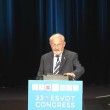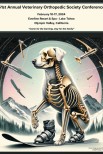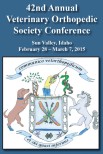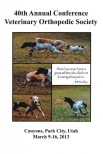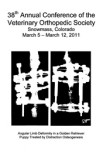
Ron McLaughlin DVM, DVSc, Diplomate ACVS
Professor and Chief, Small Animal Surgery
Chief of Staff, Animal Health Center
Head, Department of Clinical Sciences
College of Veterinary Medicine
Mississippi State University
Mississippi State, MS 39762
G.S-S. After your three years at the OVC, I think that you went straight to an academic appointment and I believe that you continued your interest in canine locomotion. Could you give readers a synopsis of how your research developed?
R. McL After completing my residency and graduate program at OVC I moved into a faculty position at Kansas State University. At KSU, through cooperation among a group of small animal and equine surgeons, we were able to develop a gait laboratory that included a computerized force plate, a scintigraphy unit, and other useful equipment. In this laboratory we completed many research projects focused on the validation of force plate data as an objective measure of limb function, including the evaluation and quantification of the numerous variables that can affect gait analysis testing. We then moved into research using gait analysis to evaluate various clinical treatments, both medical and surgical, in dogs and horses with orthopaedic conditions. This research focus has continued after my move to Mississippi State University with the addition of kinematics analysis.
G.S-S. You published quite a number of articles regarding your research. Which one are you most proud of?
R. McL That is a difficult question. Thanks to the efforts of all of the collaborators I’ve worked with over the years I think we’ve published information that has been useful to surgeons in clinical practice. But from a research perspective, the work we published on the variables that must be controlled when performing force plate gait analysis contributed significantly to moving that particular tool into the mainstream and was hopefully valuable to others engaged in orthopaedic research.
G.S-S. Research in locomotion and lameness, while being very interesting, can be very frustrating. Can you recount such events?
R. McL You are absolutely right. And I guess that might be said about many types of research, particularly in the early stages. The biggest challenge for me when performing locomotion research was working with clinical patients to collect useful data. They are unfamiliar with the process and there was a learning curve for them, and for us. I think that’s why it was so important to accurately determine the variables that impacted data collection, such as patient velocity, trial numbers, etc. Thanks to the research performed in Dr. Steve Budsberg’s laboratory, Dr. Charlie DeCamp’s laboratory, ours at KSU, and others, those factors are now better understood and our ability to collect accurate data, while reducing variability, is much better.
G.S-S. Knowing that answers uncover more questions, what do you think needs to be studied in that area?
R. McL Fortunately, gait analysis and the study of locomotion have advanced significantly over the years with the help of better technology and computer support. It is now an excellent research tool for collecting objective, scientific data about diseases that affect gait (orthopaedic and neurological conditions in particular) and for evaluating treatment options for these conditions. As new medications, surgical techniques, and supplements are developed to help patients with orthopaedic disease, the opportunity to use objective gait analysis to evaluate and compare these treatment options will continue. Currently the use of force plate gait analysis in individual clinical patients to diagnose the cause of lameness remains uncommon, in part because improved imaging techniques are available (such as CT and MRI) that commonly provide an accurate diagnosis. So, force plate analysis is primarily used to objectively monitor progress after treatment and as a research tool.


